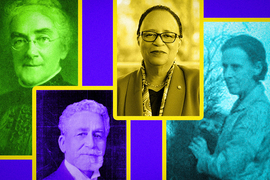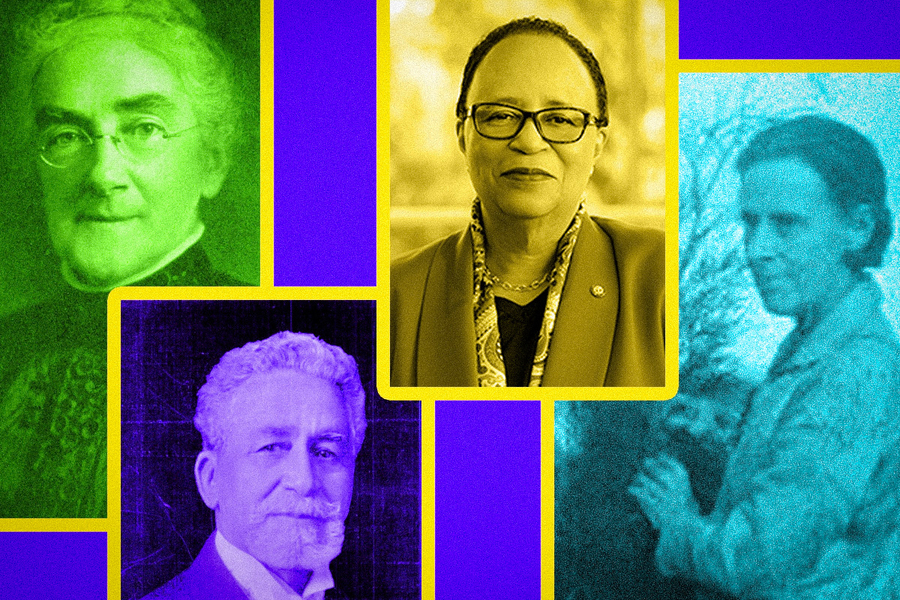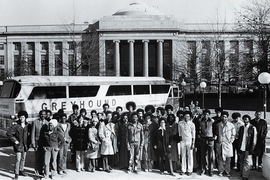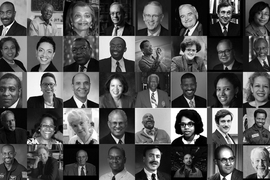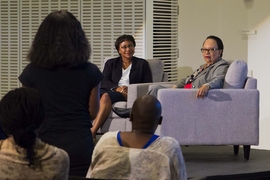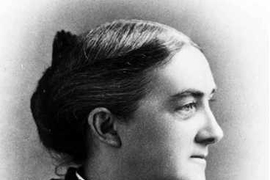With the Covid-19 pandemic squelching a lot of typical summer research activities for MIT students in 2020, three undergraduates joined forces for a different kind project: researching and writing a theatrical script about the lives of pioneering MIT students. Sponsored by visiting professor Jeffrey Toney as part of MIT’s Undergraduate Research Opportunities Program (UROP), the script was a collaboration between junior Rose Bielak, a physics student; junior Valerie Chen, a political science major; and sophomore Jovita Li, an applied mathematics major.
The undergraduates researched several history-making students from MIT and other institutions, and wound up writing a script in which the main figures have a dialogue across time. The play focuses on chemist and engineer Ellen Swallow Richards, the first woman admitted to MIT, in the 1860s, and later its first female instructor; Shirley Ann Jackson ’68, PhD ’73, currently the president of Rensselaer Polytechnic Institute, and, as a physics student, the first African-American woman to receive a PhD from MIT; Marion Mahony Griffin, the second female architecture graduate of MIT, in 1894, and a noted member of the Prairie School style; and Richard Greener, who in 1870 became the first African-American graduate of Harvard University and later served as dean of Howard University’s law school.
“I was so impressed with how they internalized the research,” says Toney, the provost and vice president for research and faculty at Kean University, a former MIT postdoc in chemistry, a visiting professor in MIT’s Department of Linguistics and Philosophy, and a visiting scholar in Harvard University's Department of the History of Science. MIT News spoke with Bielak, Chen, and Li about the experience of researching and writing about these historical figures.
Q: How did this project start and why did it interest you?
Li: I thought it was interesting because it was something I didn’t quite expect from MIT. Being a freshman who had had a quarter of the year just completely slashed, I wanted to do something related to school over the summer. And it was good to honor these figures, who were pioneers and paved the way for people like us.
Q: Are there particular aspects of their lives that jumped out the most?
Bielak: For me it was the isolation. Shirley Ann Jackson and Ellen Swallow Richards faced almost complete social isolation, in enforced and non-enforced ways. And through that, the fact that they reached such great heights, and never slowed down or gave up. Ellen Swallow Richards didn’t even get to be in the classroom with the guys at first. She was just off in some little basement and doing the exact same work as them, with no help. That was impressive to me.
Chen: We all started out researching Ellen Swallow Richards. Then I found my way to Marion Mahony Griffin and drew parallels between their ideals — for Ellen Swallow Richards, building a better environment, with a focus on chemistry and sanitation, while Marion was an architect and designer who wanted to build in harmony with the environment. Ellen Swallow Richards is more recognized now. Marion Mahony Griffin’s husband was the architect Walter Burley Griffin — they moved to Australia, so their reputation has never been as big here. They made the design for Canberra, the new capital city. She collaborated with her husband, but no one’s really sure who did how much, so she’s also been overlooked.
Q: What was the writing process like? What was most challenging?
Bielak: We spent the first couple of weeks just researching Ellen Swallow Richards, and read a lot of the same material. But from there we branched out to do our own research on other possible charaters. We would come together and talk about which had the most prospects for our play. We were all writing our own scenes and we would share them. It was a lot of individual work that grew together.
Li: Right at the end of the summer when the UROP period was ending we stitched the scenes together in an order that made sense. We kind of quilted it together. For me the toughest part was writing dialogue that sounded like something real people would say, as opposed to just throwing in our facts and themes and the points we wanted to get across — we’re trying to embody the characters and show, not tell.
Chen: It’s about exploring the frameworks they thought in, while not attributing things to them that we think they should have believed in, when we have no evidence either way.
Q: Do you relate this all to your own experience? You’re in a different situation today, but to what extent are people still dealing with these issues of acceptance, isolation, and stereotypes in different fields?
Bielak: Obviously we’ve come such a long way since any of these women were at MIT, so I suppose the differences are pretty stark. But there is always an undercurrent of feeling like a bit of an underdog as a woman in STEM. You’re never going to be discouraged, but you’ll see very little representation in a number of fields. So we are lucky in a lot of ways, but despite the fact that there isn’t any verbal or obvious discouragement, people absorb the things they see, and that remains in your mind a little bit. At the same time we’ve come so far. 150 years ago, Ellen Swallow Richards was stuck in a basement.
Q: Would you like to get this script produced? What are the next steps?
Bielak: Yes. I mean, it’s obviously hard with the current situation in the world. This is a penultimate version of the draft, but we’re going to figure out in what capacity it could be performed. At one point, we were thinking about a podcast or an onstage play. We definitely would be interested in reaching out to some play groups and seeing if anyone would want to perform it.
Li: As things start opening up, we’ll want to return to the project and see what more we can do with it.
